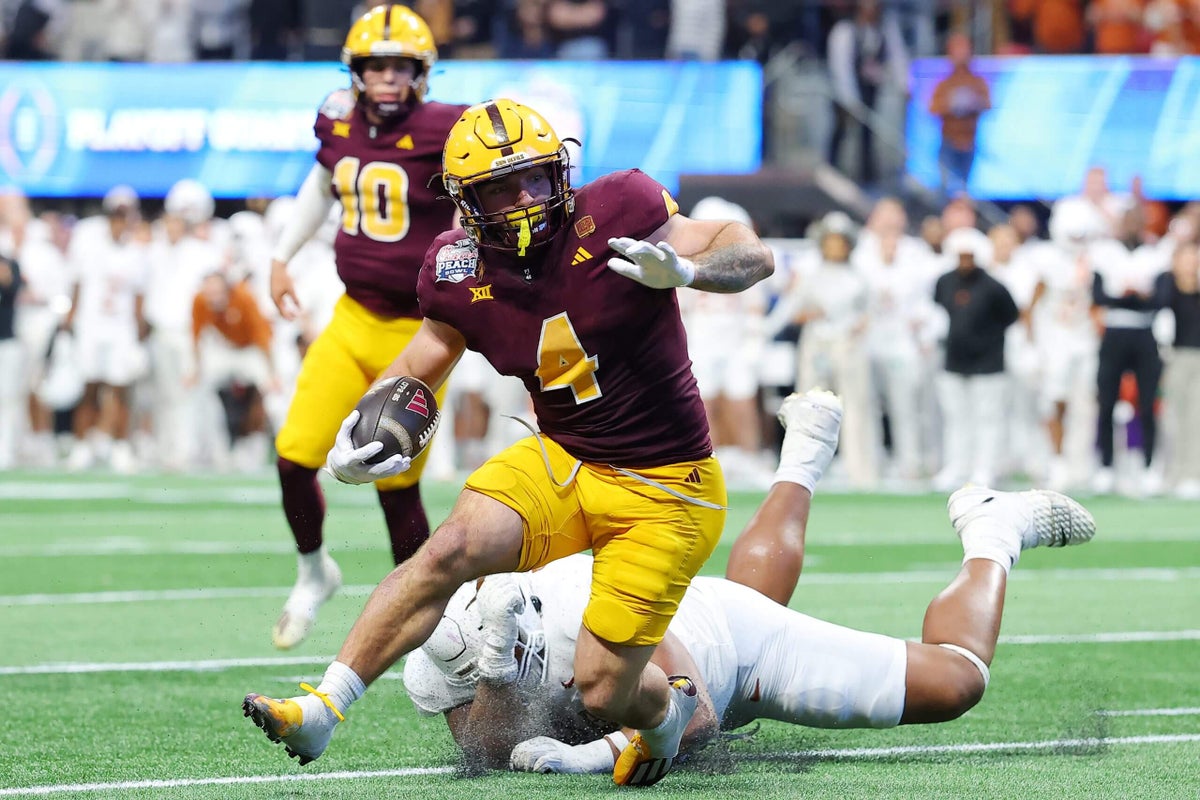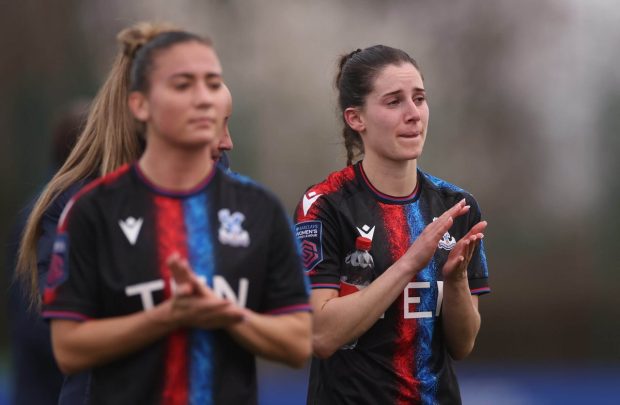

LAKE FOREST, Ill. — The third day of the NFL Draft will have an earlier start for the Chicago Bears after a Day 2 move with the Buffalo Bills.
The Bears exchanged the 41st, 72nd and the 240th selections for Nos. 56, 62 and 109. They get the fourth-round pick back that they traded last year to move up for defensive end Austin Booker.
Advertisement
After taking offensive tackle Ozzy Trapilo and defensive tackle Shemar Turner on Friday night, does the 109th pick become the Bears’ move at running back?
Bears director of player personnel Trey Koziol was asked about the possibility of adding a running back on Day 3.
“Sure, any time you have an opportunity to add a good player there,” he said. “There’s still a lot of players on the board we’d be thrilled to add. It’s just gonna depend on how things shake out these last 24 hours.”
Here’s a look at potential fits for the Bears on Day 3 of the NFL Draft. All excerpts are from The Athletic’s Dane Brugler and “The Beast.”
The running backs
The benefit of a deep running back class is the Bears will have their options in Rounds 4 and 5 to join D’Andre Swift and Roschon Johnson in the backfield.
And there are many.
Cam Skattebo, Arizona State
Brugler: “Skattebo is a thickly built, compact runner who is more quick than explosive, but he competes with tremendous resolve and understands how to rely on his pad level and contact balance to get the most out of every carry. He is a draftable option for a team looking to upgrade its backfield physicality.”
Trevor Etienne, Georgia
Brugler: “There might not be anything exceptional about Etienne’s game, but he also doesn’t have any glaring weaknesses that would keep him from seeing steady NFL snaps. His promise as a pass catcher and blocker gives him value on all three downs.”
Damien Martinez, Miami
Brugler: “Martinez doesn’t have the burst or wiggle to consistently make defenders miss, but he can power through/over them and prides himself on his finishing ability to churn out positive yards. He can be a “dirty work” runner on an NFL depth chart.”
Devin Neal, Kansas
Brugler: “With his square running style, Neal sees the field well and utilizes his patience, loose slides and timing to create mismanaged pursuit angles. Though not a burner, he is a great example that throttling speed is more important than sprinting speed at the running back position.
Advertisement
Dylan Sampson, Tennessee
Brugler: “Although it looks chaotic at times when he plays in overdrive, Sampson runs with urgent speed getting through the first wave, and his sharp lateral cuts open up the field. He isn’t powerful, but he runs with outstanding competitiveness and averaged a touchdown every 12.1 carries in college.”
Ollie Gordon, Oklahoma State
Brugler: “Gordon runs with life in his legs that makes him a threat any time he touches the rock, but he must improve his decision-making and physicality as a finisher to be a consistent down-to-down runner. His promise as a blocker and pass catcher will help his chances on an NFL depth chart.”
Brashard Smith, SMU
Brugler: “Durable and didn’t appear to wear down late in games or the season (Mario Cristobal: “He’s like a piece of iron. He can go forever.”) … One of only eight FBS players to average more than 140 all-purpose yards per game in 2024 (141.2).”
Other offensive options
The selection of Boston College offensive tackle Ozzy Trapilo should have eased some fans’ concern about the lack of a pick in the trenches, but the Bears could always keep adding along the offensive line. They got their tight end and receiver, but wideout is a premium position where there could still be room to add late.
Cameron Williams, OT, Texas
Brugler: “Williams is incredibly raw, which presents itself in several ways, but the physical traits and power are easy to identify and will have NFL offensive line coaches excited about developing him. As long as his knee is healthy, he has down-the-road starting ability at tackle or guard.”
Jaylin Lane, WR, Virginia Tech
Brugler: “He is capable of stretching the field vertically (dynamic on slot posts), although he needs work in the intermediate part of the field to better set up defenders, win body position and finish crowded catch points.”
Advertisement
Dontae Fleming, WR, Tulane
Fleming (6-0, 175 pounds) ran the 40 in 4.4 seconds, according to “The Beast,” which graded him as a priority free agent. He did visit the Bears before the draft. Fleming made 31 catches for 598 yards and a touchdown in his final college season. He also has experience returning punts. Before Tulane, Fleming played at Louisiana (Lafayette).
Luke Lachey, TE, Iowa
Brugler: “Lachey doesn’t have any dynamic elements in his game, but he catches the ball cleanly and is willing to do the dirty work in the run game. His competitive wiring will help him compete for a backup role in the NFL.”
Jonah Monheim, OL, USC
Brugler: “Monheim has outstanding makeup and foot quickness, with experience across the offensive line, but his lack of length alone will eliminate him from consideration for several NFL teams. He projects as a depth piece who can earn a roster spot as a backup center.”
Addison West, OL, Western Michigan
West (6-2 ½, 300 pounds) was listed as a priority free agent but he visited the Bears during the predraft process. A local product from Cary-Grove, West was the second player in Western Michigan school history to become an FBS Consensus All-American.
Jalin Conyers, TE, Texas Tech
Brugler: “Conyers has a basketball background, which shows in the quick-footed movements in his lower body and the flexibility in his upper half to easily adjust at the catch point. He isn’t polished as a route runner or blocker, but he can sink, and there is plenty of room for maturation in both areas.”
Defensive options
The Bears still have a young, talented defense with three players who have been to a Pro Bowl. The needs aren’t necessarily for 2025, especially on Day 3, but it’s about adding depth, hoping to find some players who can develop into starters in ‘26 and beyond. Linebackers and defensive backs could be contributors on Richard Hightower’s special-teams unit, and you can never have enough pass rushers. Edge rusher is the most important position, but safety has the most question marks after this upcoming season.
Jack Sawyer, edge, Ohio State
Brugler: “Sawyer often plays one-dimensionally as a pass rusher and lacks ideal suddenness or length for an edge player, but his activity level and the strength in his hands make him an every-down factor. Similar in ways to George Karlaftis, he has the competitive play personality that NFL coaches will welcome as part of their rotation.”
Tyrion Ingram-Dawkins, edge, Georgia
Brugler: “Ingram-Dawkins doesn’t have a strong body of work, but if you grade to the flashes and trust the size and athletic traits, it is easy to be excited about his pro potential. He offers inside-outside versatility — some NFL teams view him as more of an edge presence; others want his explosiveness over the B-gap.”
Advertisement
Kyle Kennard, edge, South Carolina
Brugler: “Kennard has work to do developing his counters and becoming more consistent on run downs to reach his NFL potential, but he brings energetic speed off the edge when he can pin his ears back. He projects as a passing-down specialist, and his role can evolve from there.”
Fadil Diggs, edge, Syracuse
Brugler: “Diggs might not have any exceptional traits that separate him, but he is a well-rounded player with enough athleticism and physicality packed into an NFL frame. He projects as a scheme-versatile NFL backup who can provide a nice changeup off the bench.”
Zah Frazier, CB, Texas San Antonio
Brugler: “Frazier is a long, lean bump-and-run corner with the speed and coordination to cling to receivers and find the football when his technique stays consistent. There isn’t much mystery why a team might feel he is worth the gamble on Day 3 of the draft.”
Ruben Hyppolite, LB, Maryland
He’s not even 6-feet, which has him as a priority free agent in “The Beast,” but he’s fast — his 4.42 40-time ranks in the 99th percentile of linebackers and his three-cone time would be in the 89th percentile. Started all 12 games last season and had 6.5 tackles for loss.
Malachi Moore, S, Alabama
Brugler: “Moore doesn’t have difference-making size or athletic traits, but he is a tough, instinctive player who can defend the run and play with just enough range in coverage. He projects best as a post or half-field safety in zone, which would allow him to patrol, work top-down and be a solid NFL contributor.”
Sebastian Castro, S, Iowa
Brugler: “Castro is an instinctive zone defender with trustworthy football character, but his ordinary speed and explosiveness limit his upside in most schemes. He best fits as a big nickel safety, likely as a backup.”
Hunter Wohler, S, Wisconsin
Brugler: “Wohler is a one-speed athlete and will be limited as a true coverage player at the next level, but his read-react ability and competitive edge versus the run should give him NFL value. He might not be an ideal starter, but he has the tools to hang around as a quality depth piece and special teamer.”
Advertisement
Jordan Phillips, DT, Maryland
Brugler: “A toolsy prospect, Phillips jumps off the film with his light feet, explosive movements and heavy hands. Though it is encouraging that he is one of the youngest players in the draft class, his inexperience jumps off the film — he’s often neutralized and off balance, especially when he is late off the ball.”
CJ West, DT, Indiana
Brugler: “The No. 1 criteria when scouting defensive linemen is to find the guys that hate to be blocked, and West falls into that category with his fast, strong hands and high energy level.”
(Photo of Cam Skattebo: Kevin C. Cox / Getty Images)
This news was originally published on this post .









Be the first to leave a comment